Risk Management: How UK Construction Addresses Climate Change
VerifiedAdded on 2023/06/16
|8
|2100
|149
Essay
AI Summary
This essay examines the UK construction industry's significant contribution to the climate emergency, focusing on carbon emissions and resource utilization. It evaluates how the industry can manage climate change risks, emphasizing strategies like reducing carbon emissions, adopting climate-smart energy consumption, and using recyclable materials. The essay highlights the industry's commitment to building resilience against extreme weather events and improving water management. It concludes by advocating for sustainable working practices, increased awareness, and the integration of innovative technologies like robotic construction and BIM to mitigate the adverse environmental impact and promote a net-zero construction industry in the United Kingdom. Desklib provides access to similar essays and study resources for students.
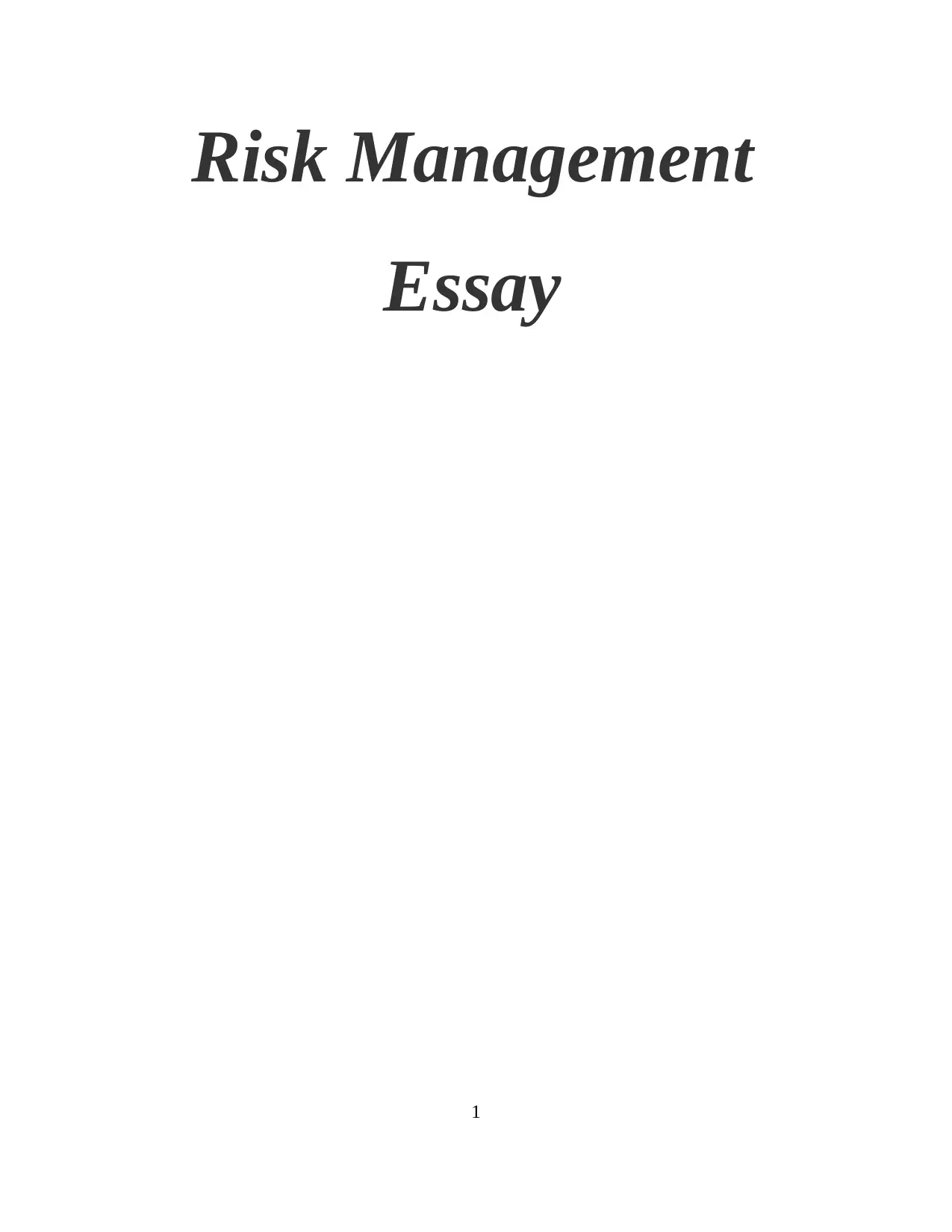
Risk Management
Essay
1
Essay
1
Paraphrase This Document
Need a fresh take? Get an instant paraphrase of this document with our AI Paraphraser
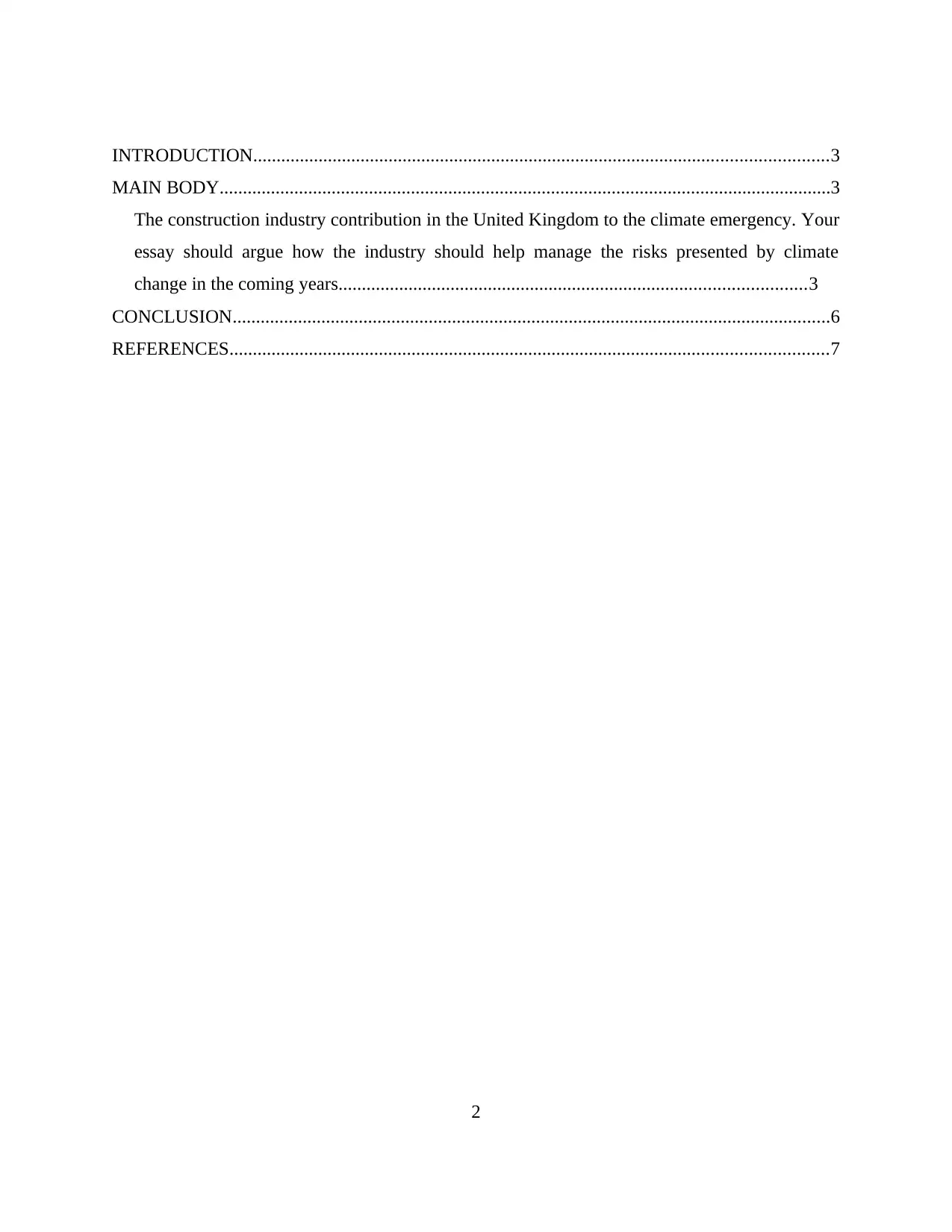
INTRODUCTION...........................................................................................................................3
MAIN BODY...................................................................................................................................3
The construction industry contribution in the United Kingdom to the climate emergency. Your
essay should argue how the industry should help manage the risks presented by climate
change in the coming years....................................................................................................3
CONCLUSION................................................................................................................................6
REFERENCES................................................................................................................................7
2
MAIN BODY...................................................................................................................................3
The construction industry contribution in the United Kingdom to the climate emergency. Your
essay should argue how the industry should help manage the risks presented by climate
change in the coming years....................................................................................................3
CONCLUSION................................................................................................................................6
REFERENCES................................................................................................................................7
2
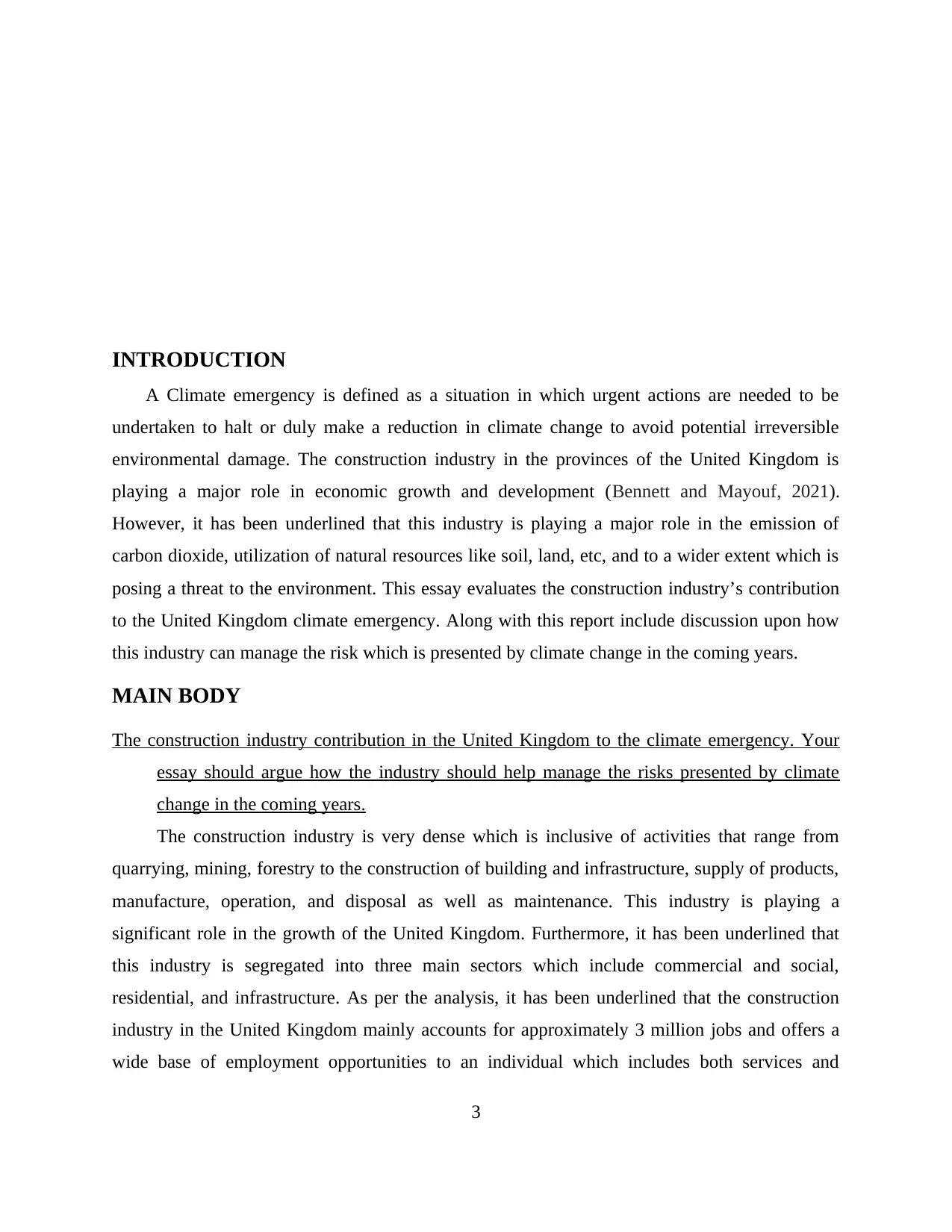
INTRODUCTION
A Climate emergency is defined as a situation in which urgent actions are needed to be
undertaken to halt or duly make a reduction in climate change to avoid potential irreversible
environmental damage. The construction industry in the provinces of the United Kingdom is
playing a major role in economic growth and development (Bennett and Mayouf, 2021).
However, it has been underlined that this industry is playing a major role in the emission of
carbon dioxide, utilization of natural resources like soil, land, etc, and to a wider extent which is
posing a threat to the environment. This essay evaluates the construction industry’s contribution
to the United Kingdom climate emergency. Along with this report include discussion upon how
this industry can manage the risk which is presented by climate change in the coming years.
MAIN BODY
The construction industry contribution in the United Kingdom to the climate emergency. Your
essay should argue how the industry should help manage the risks presented by climate
change in the coming years.
The construction industry is very dense which is inclusive of activities that range from
quarrying, mining, forestry to the construction of building and infrastructure, supply of products,
manufacture, operation, and disposal as well as maintenance. This industry is playing a
significant role in the growth of the United Kingdom. Furthermore, it has been underlined that
this industry is segregated into three main sectors which include commercial and social,
residential, and infrastructure. As per the analysis, it has been underlined that the construction
industry in the United Kingdom mainly accounts for approximately 3 million jobs and offers a
wide base of employment opportunities to an individual which includes both services and
3
A Climate emergency is defined as a situation in which urgent actions are needed to be
undertaken to halt or duly make a reduction in climate change to avoid potential irreversible
environmental damage. The construction industry in the provinces of the United Kingdom is
playing a major role in economic growth and development (Bennett and Mayouf, 2021).
However, it has been underlined that this industry is playing a major role in the emission of
carbon dioxide, utilization of natural resources like soil, land, etc, and to a wider extent which is
posing a threat to the environment. This essay evaluates the construction industry’s contribution
to the United Kingdom climate emergency. Along with this report include discussion upon how
this industry can manage the risk which is presented by climate change in the coming years.
MAIN BODY
The construction industry contribution in the United Kingdom to the climate emergency. Your
essay should argue how the industry should help manage the risks presented by climate
change in the coming years.
The construction industry is very dense which is inclusive of activities that range from
quarrying, mining, forestry to the construction of building and infrastructure, supply of products,
manufacture, operation, and disposal as well as maintenance. This industry is playing a
significant role in the growth of the United Kingdom. Furthermore, it has been underlined that
this industry is segregated into three main sectors which include commercial and social,
residential, and infrastructure. As per the analysis, it has been underlined that the construction
industry in the United Kingdom mainly accounts for approximately 3 million jobs and offers a
wide base of employment opportunities to an individual which includes both services and
3
⊘ This is a preview!⊘
Do you want full access?
Subscribe today to unlock all pages.

Trusted by 1+ million students worldwide
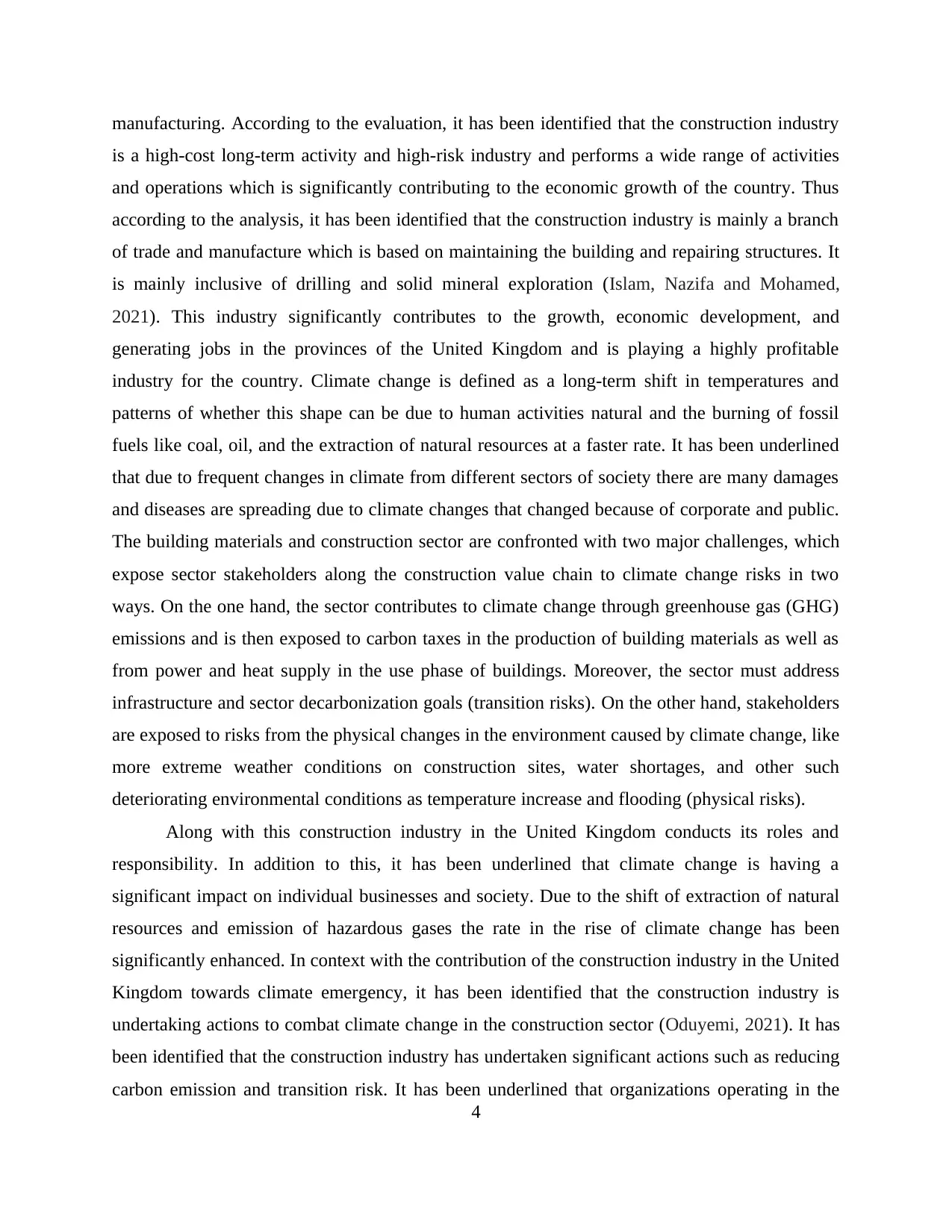
manufacturing. According to the evaluation, it has been identified that the construction industry
is a high-cost long-term activity and high-risk industry and performs a wide range of activities
and operations which is significantly contributing to the economic growth of the country. Thus
according to the analysis, it has been identified that the construction industry is mainly a branch
of trade and manufacture which is based on maintaining the building and repairing structures. It
is mainly inclusive of drilling and solid mineral exploration (Islam, Nazifa and Mohamed,
2021). This industry significantly contributes to the growth, economic development, and
generating jobs in the provinces of the United Kingdom and is playing a highly profitable
industry for the country. Climate change is defined as a long-term shift in temperatures and
patterns of whether this shape can be due to human activities natural and the burning of fossil
fuels like coal, oil, and the extraction of natural resources at a faster rate. It has been underlined
that due to frequent changes in climate from different sectors of society there are many damages
and diseases are spreading due to climate changes that changed because of corporate and public.
The building materials and construction sector are confronted with two major challenges, which
expose sector stakeholders along the construction value chain to climate change risks in two
ways. On the one hand, the sector contributes to climate change through greenhouse gas (GHG)
emissions and is then exposed to carbon taxes in the production of building materials as well as
from power and heat supply in the use phase of buildings. Moreover, the sector must address
infrastructure and sector decarbonization goals (transition risks). On the other hand, stakeholders
are exposed to risks from the physical changes in the environment caused by climate change, like
more extreme weather conditions on construction sites, water shortages, and other such
deteriorating environmental conditions as temperature increase and flooding (physical risks).
Along with this construction industry in the United Kingdom conducts its roles and
responsibility. In addition to this, it has been underlined that climate change is having a
significant impact on individual businesses and society. Due to the shift of extraction of natural
resources and emission of hazardous gases the rate in the rise of climate change has been
significantly enhanced. In context with the contribution of the construction industry in the United
Kingdom towards climate emergency, it has been identified that the construction industry is
undertaking actions to combat climate change in the construction sector (Oduyemi, 2021). It has
been identified that the construction industry has undertaken significant actions such as reducing
carbon emission and transition risk. It has been underlined that organizations operating in the
4
is a high-cost long-term activity and high-risk industry and performs a wide range of activities
and operations which is significantly contributing to the economic growth of the country. Thus
according to the analysis, it has been identified that the construction industry is mainly a branch
of trade and manufacture which is based on maintaining the building and repairing structures. It
is mainly inclusive of drilling and solid mineral exploration (Islam, Nazifa and Mohamed,
2021). This industry significantly contributes to the growth, economic development, and
generating jobs in the provinces of the United Kingdom and is playing a highly profitable
industry for the country. Climate change is defined as a long-term shift in temperatures and
patterns of whether this shape can be due to human activities natural and the burning of fossil
fuels like coal, oil, and the extraction of natural resources at a faster rate. It has been underlined
that due to frequent changes in climate from different sectors of society there are many damages
and diseases are spreading due to climate changes that changed because of corporate and public.
The building materials and construction sector are confronted with two major challenges, which
expose sector stakeholders along the construction value chain to climate change risks in two
ways. On the one hand, the sector contributes to climate change through greenhouse gas (GHG)
emissions and is then exposed to carbon taxes in the production of building materials as well as
from power and heat supply in the use phase of buildings. Moreover, the sector must address
infrastructure and sector decarbonization goals (transition risks). On the other hand, stakeholders
are exposed to risks from the physical changes in the environment caused by climate change, like
more extreme weather conditions on construction sites, water shortages, and other such
deteriorating environmental conditions as temperature increase and flooding (physical risks).
Along with this construction industry in the United Kingdom conducts its roles and
responsibility. In addition to this, it has been underlined that climate change is having a
significant impact on individual businesses and society. Due to the shift of extraction of natural
resources and emission of hazardous gases the rate in the rise of climate change has been
significantly enhanced. In context with the contribution of the construction industry in the United
Kingdom towards climate emergency, it has been identified that the construction industry is
undertaking actions to combat climate change in the construction sector (Oduyemi, 2021). It has
been identified that the construction industry has undertaken significant actions such as reducing
carbon emission and transition risk. It has been underlined that organizations operating in the
4
Paraphrase This Document
Need a fresh take? Get an instant paraphrase of this document with our AI Paraphraser
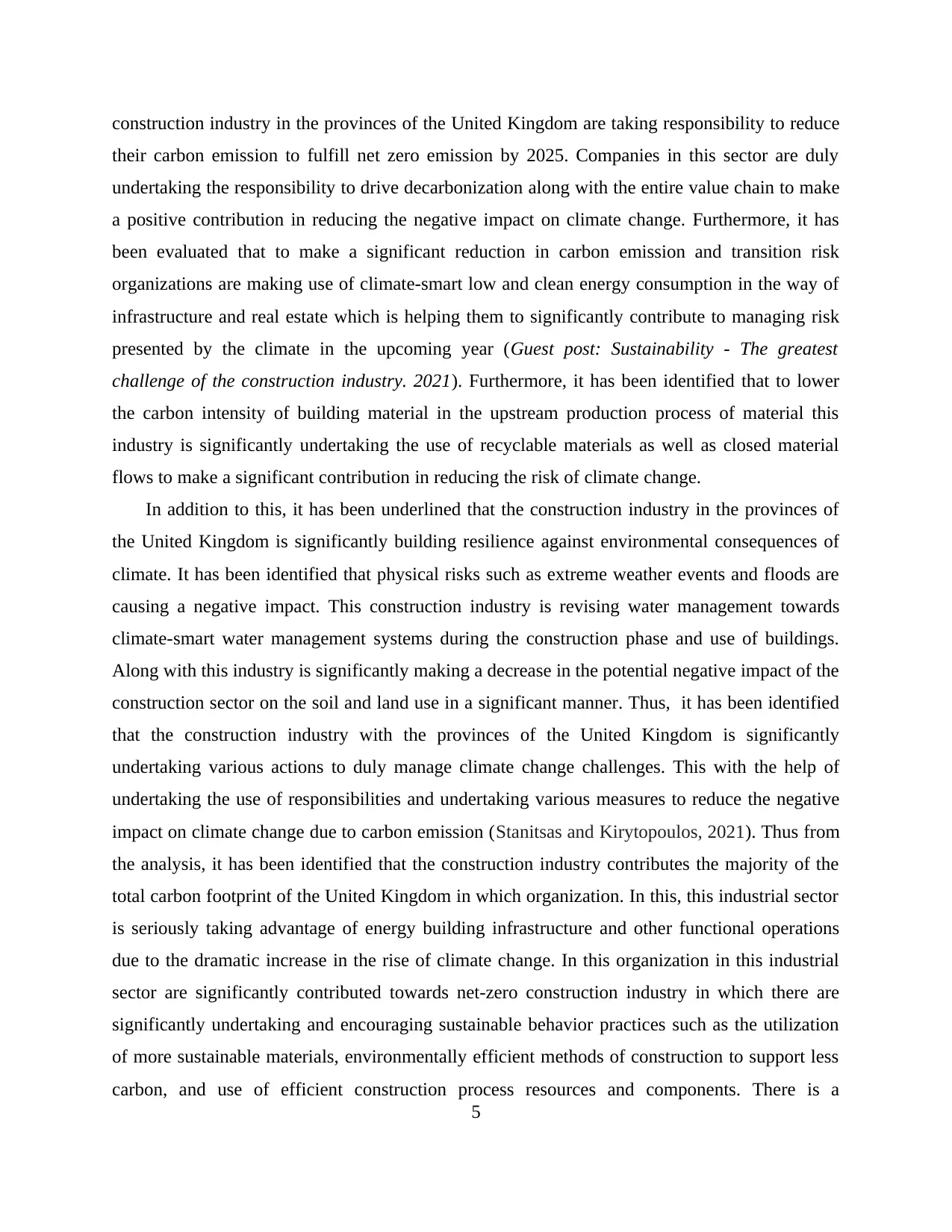
construction industry in the provinces of the United Kingdom are taking responsibility to reduce
their carbon emission to fulfill net zero emission by 2025. Companies in this sector are duly
undertaking the responsibility to drive decarbonization along with the entire value chain to make
a positive contribution in reducing the negative impact on climate change. Furthermore, it has
been evaluated that to make a significant reduction in carbon emission and transition risk
organizations are making use of climate-smart low and clean energy consumption in the way of
infrastructure and real estate which is helping them to significantly contribute to managing risk
presented by the climate in the upcoming year (Guest post: Sustainability - The greatest
challenge of the construction industry. 2021). Furthermore, it has been identified that to lower
the carbon intensity of building material in the upstream production process of material this
industry is significantly undertaking the use of recyclable materials as well as closed material
flows to make a significant contribution in reducing the risk of climate change.
In addition to this, it has been underlined that the construction industry in the provinces of
the United Kingdom is significantly building resilience against environmental consequences of
climate. It has been identified that physical risks such as extreme weather events and floods are
causing a negative impact. This construction industry is revising water management towards
climate-smart water management systems during the construction phase and use of buildings.
Along with this industry is significantly making a decrease in the potential negative impact of the
construction sector on the soil and land use in a significant manner. Thus, it has been identified
that the construction industry with the provinces of the United Kingdom is significantly
undertaking various actions to duly manage climate change challenges. This with the help of
undertaking the use of responsibilities and undertaking various measures to reduce the negative
impact on climate change due to carbon emission (Stanitsas and Kirytopoulos, 2021). Thus from
the analysis, it has been identified that the construction industry contributes the majority of the
total carbon footprint of the United Kingdom in which organization. In this, this industrial sector
is seriously taking advantage of energy building infrastructure and other functional operations
due to the dramatic increase in the rise of climate change. In this organization in this industrial
sector are significantly contributed towards net-zero construction industry in which there are
significantly undertaking and encouraging sustainable behavior practices such as the utilization
of more sustainable materials, environmentally efficient methods of construction to support less
carbon, and use of efficient construction process resources and components. There is a
5
their carbon emission to fulfill net zero emission by 2025. Companies in this sector are duly
undertaking the responsibility to drive decarbonization along with the entire value chain to make
a positive contribution in reducing the negative impact on climate change. Furthermore, it has
been evaluated that to make a significant reduction in carbon emission and transition risk
organizations are making use of climate-smart low and clean energy consumption in the way of
infrastructure and real estate which is helping them to significantly contribute to managing risk
presented by the climate in the upcoming year (Guest post: Sustainability - The greatest
challenge of the construction industry. 2021). Furthermore, it has been identified that to lower
the carbon intensity of building material in the upstream production process of material this
industry is significantly undertaking the use of recyclable materials as well as closed material
flows to make a significant contribution in reducing the risk of climate change.
In addition to this, it has been underlined that the construction industry in the provinces of
the United Kingdom is significantly building resilience against environmental consequences of
climate. It has been identified that physical risks such as extreme weather events and floods are
causing a negative impact. This construction industry is revising water management towards
climate-smart water management systems during the construction phase and use of buildings.
Along with this industry is significantly making a decrease in the potential negative impact of the
construction sector on the soil and land use in a significant manner. Thus, it has been identified
that the construction industry with the provinces of the United Kingdom is significantly
undertaking various actions to duly manage climate change challenges. This with the help of
undertaking the use of responsibilities and undertaking various measures to reduce the negative
impact on climate change due to carbon emission (Stanitsas and Kirytopoulos, 2021). Thus from
the analysis, it has been identified that the construction industry contributes the majority of the
total carbon footprint of the United Kingdom in which organization. In this, this industrial sector
is seriously taking advantage of energy building infrastructure and other functional operations
due to the dramatic increase in the rise of climate change. In this organization in this industrial
sector are significantly contributed towards net-zero construction industry in which there are
significantly undertaking and encouraging sustainable behavior practices such as the utilization
of more sustainable materials, environmentally efficient methods of construction to support less
carbon, and use of efficient construction process resources and components. There is a
5
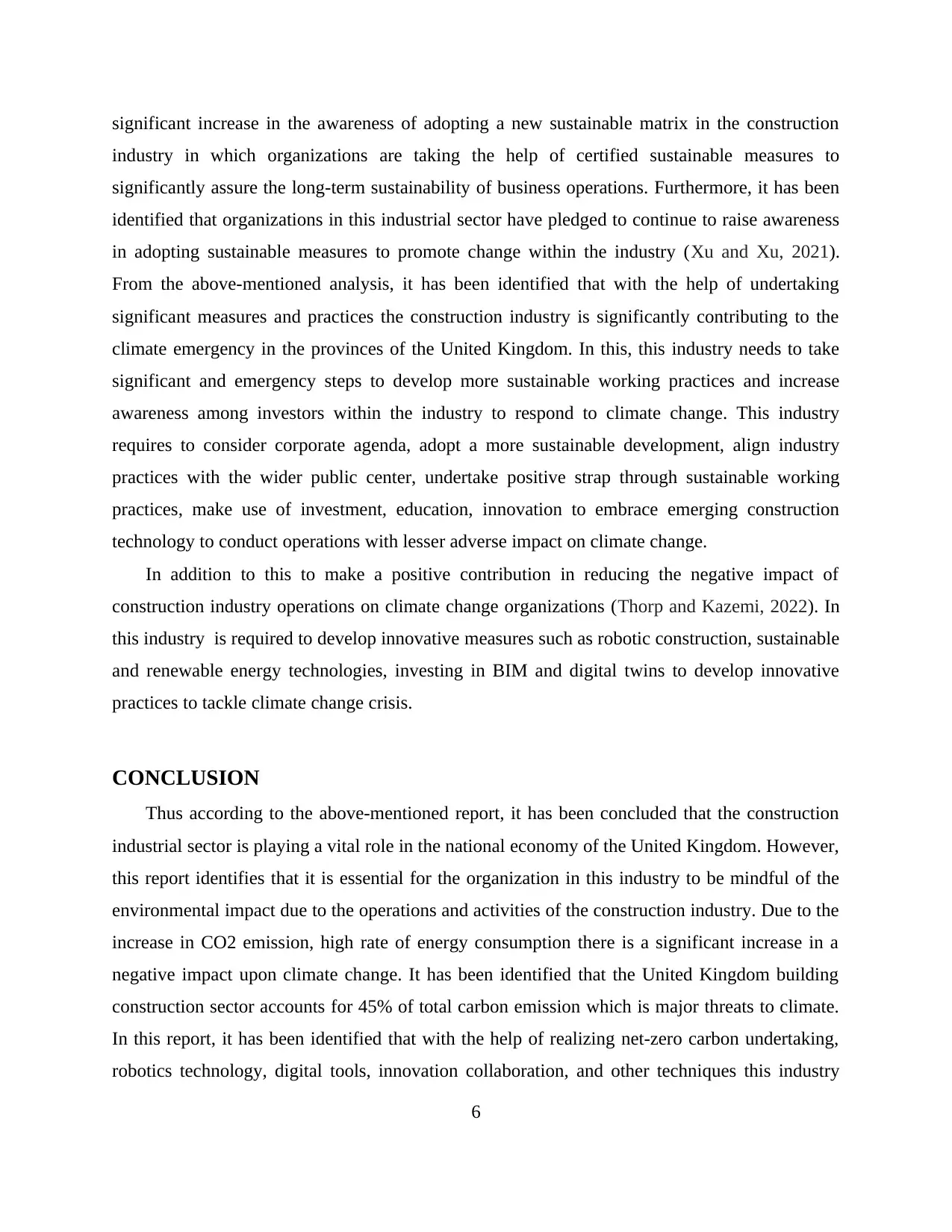
significant increase in the awareness of adopting a new sustainable matrix in the construction
industry in which organizations are taking the help of certified sustainable measures to
significantly assure the long-term sustainability of business operations. Furthermore, it has been
identified that organizations in this industrial sector have pledged to continue to raise awareness
in adopting sustainable measures to promote change within the industry (Xu and Xu, 2021).
From the above-mentioned analysis, it has been identified that with the help of undertaking
significant measures and practices the construction industry is significantly contributing to the
climate emergency in the provinces of the United Kingdom. In this, this industry needs to take
significant and emergency steps to develop more sustainable working practices and increase
awareness among investors within the industry to respond to climate change. This industry
requires to consider corporate agenda, adopt a more sustainable development, align industry
practices with the wider public center, undertake positive strap through sustainable working
practices, make use of investment, education, innovation to embrace emerging construction
technology to conduct operations with lesser adverse impact on climate change.
In addition to this to make a positive contribution in reducing the negative impact of
construction industry operations on climate change organizations (Thorp and Kazemi, 2022). In
this industry is required to develop innovative measures such as robotic construction, sustainable
and renewable energy technologies, investing in BIM and digital twins to develop innovative
practices to tackle climate change crisis.
CONCLUSION
Thus according to the above-mentioned report, it has been concluded that the construction
industrial sector is playing a vital role in the national economy of the United Kingdom. However,
this report identifies that it is essential for the organization in this industry to be mindful of the
environmental impact due to the operations and activities of the construction industry. Due to the
increase in CO2 emission, high rate of energy consumption there is a significant increase in a
negative impact upon climate change. It has been identified that the United Kingdom building
construction sector accounts for 45% of total carbon emission which is major threats to climate.
In this report, it has been identified that with the help of realizing net-zero carbon undertaking,
robotics technology, digital tools, innovation collaboration, and other techniques this industry
6
industry in which organizations are taking the help of certified sustainable measures to
significantly assure the long-term sustainability of business operations. Furthermore, it has been
identified that organizations in this industrial sector have pledged to continue to raise awareness
in adopting sustainable measures to promote change within the industry (Xu and Xu, 2021).
From the above-mentioned analysis, it has been identified that with the help of undertaking
significant measures and practices the construction industry is significantly contributing to the
climate emergency in the provinces of the United Kingdom. In this, this industry needs to take
significant and emergency steps to develop more sustainable working practices and increase
awareness among investors within the industry to respond to climate change. This industry
requires to consider corporate agenda, adopt a more sustainable development, align industry
practices with the wider public center, undertake positive strap through sustainable working
practices, make use of investment, education, innovation to embrace emerging construction
technology to conduct operations with lesser adverse impact on climate change.
In addition to this to make a positive contribution in reducing the negative impact of
construction industry operations on climate change organizations (Thorp and Kazemi, 2022). In
this industry is required to develop innovative measures such as robotic construction, sustainable
and renewable energy technologies, investing in BIM and digital twins to develop innovative
practices to tackle climate change crisis.
CONCLUSION
Thus according to the above-mentioned report, it has been concluded that the construction
industrial sector is playing a vital role in the national economy of the United Kingdom. However,
this report identifies that it is essential for the organization in this industry to be mindful of the
environmental impact due to the operations and activities of the construction industry. Due to the
increase in CO2 emission, high rate of energy consumption there is a significant increase in a
negative impact upon climate change. It has been identified that the United Kingdom building
construction sector accounts for 45% of total carbon emission which is major threats to climate.
In this report, it has been identified that with the help of realizing net-zero carbon undertaking,
robotics technology, digital tools, innovation collaboration, and other techniques this industry
6
⊘ This is a preview!⊘
Do you want full access?
Subscribe today to unlock all pages.

Trusted by 1+ million students worldwide
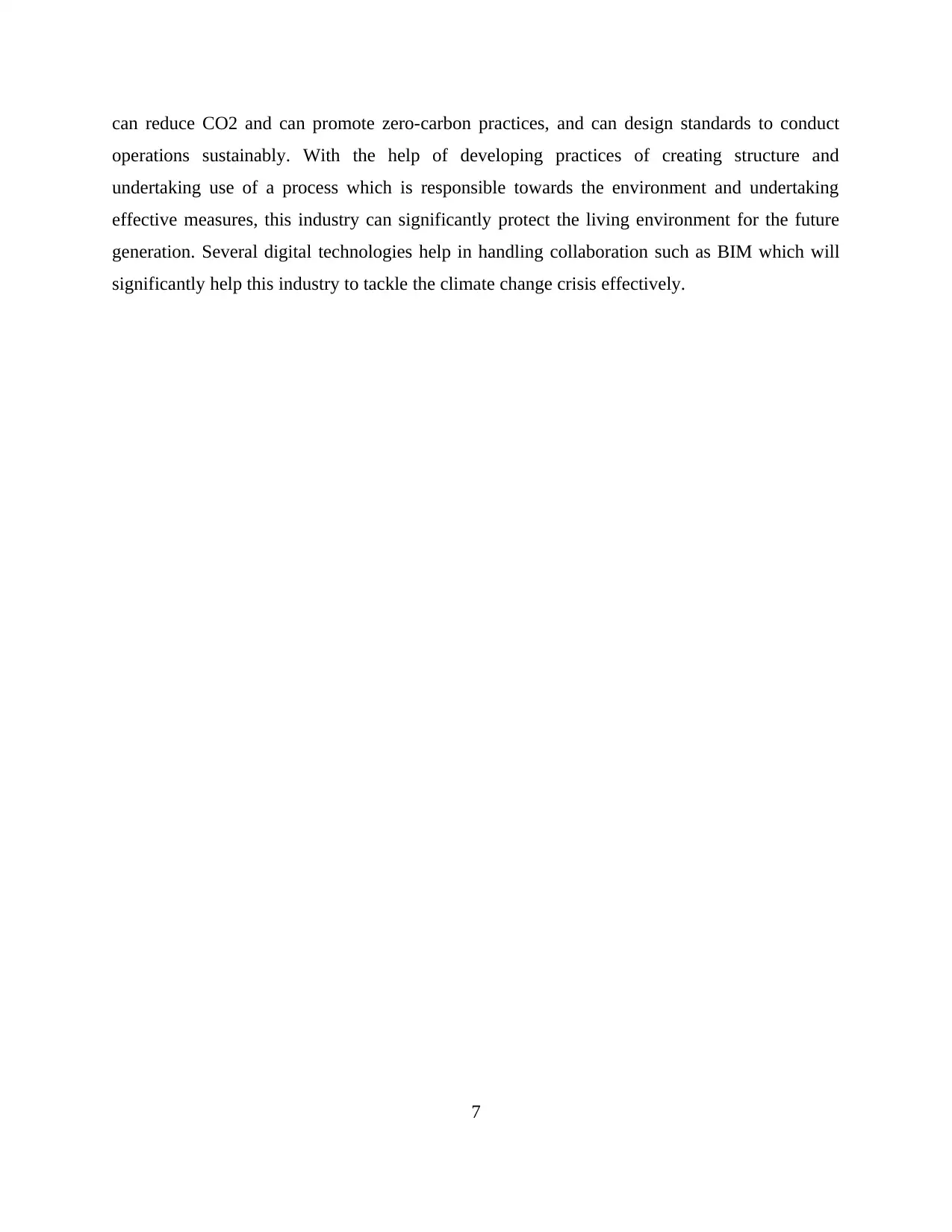
can reduce CO2 and can promote zero-carbon practices, and can design standards to conduct
operations sustainably. With the help of developing practices of creating structure and
undertaking use of a process which is responsible towards the environment and undertaking
effective measures, this industry can significantly protect the living environment for the future
generation. Several digital technologies help in handling collaboration such as BIM which will
significantly help this industry to tackle the climate change crisis effectively.
7
operations sustainably. With the help of developing practices of creating structure and
undertaking use of a process which is responsible towards the environment and undertaking
effective measures, this industry can significantly protect the living environment for the future
generation. Several digital technologies help in handling collaboration such as BIM which will
significantly help this industry to tackle the climate change crisis effectively.
7
Paraphrase This Document
Need a fresh take? Get an instant paraphrase of this document with our AI Paraphraser
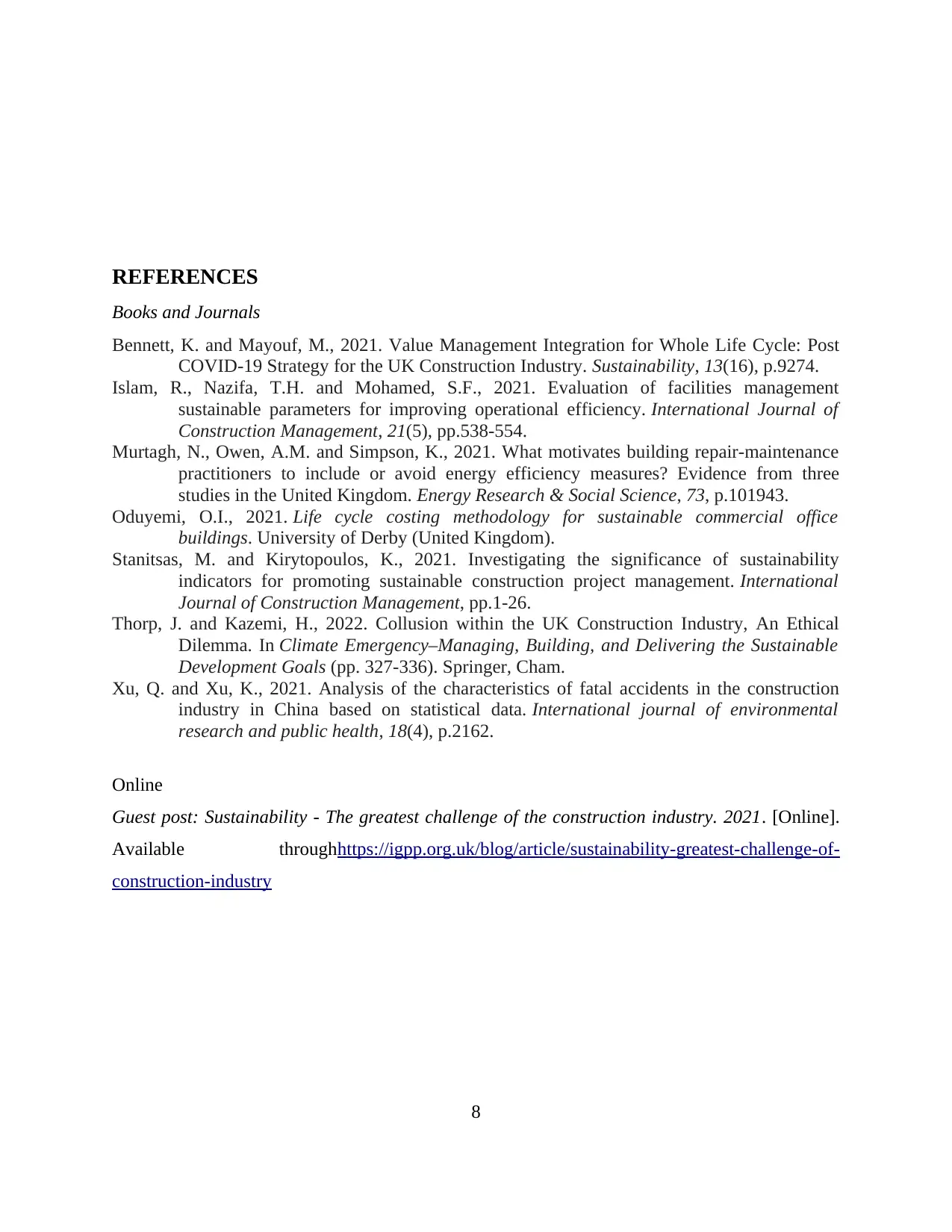
REFERENCES
Books and Journals
Bennett, K. and Mayouf, M., 2021. Value Management Integration for Whole Life Cycle: Post
COVID-19 Strategy for the UK Construction Industry. Sustainability, 13(16), p.9274.
Islam, R., Nazifa, T.H. and Mohamed, S.F., 2021. Evaluation of facilities management
sustainable parameters for improving operational efficiency. International Journal of
Construction Management, 21(5), pp.538-554.
Murtagh, N., Owen, A.M. and Simpson, K., 2021. What motivates building repair-maintenance
practitioners to include or avoid energy efficiency measures? Evidence from three
studies in the United Kingdom. Energy Research & Social Science, 73, p.101943.
Oduyemi, O.I., 2021. Life cycle costing methodology for sustainable commercial office
buildings. University of Derby (United Kingdom).
Stanitsas, M. and Kirytopoulos, K., 2021. Investigating the significance of sustainability
indicators for promoting sustainable construction project management. International
Journal of Construction Management, pp.1-26.
Thorp, J. and Kazemi, H., 2022. Collusion within the UK Construction Industry, An Ethical
Dilemma. In Climate Emergency–Managing, Building, and Delivering the Sustainable
Development Goals (pp. 327-336). Springer, Cham.
Xu, Q. and Xu, K., 2021. Analysis of the characteristics of fatal accidents in the construction
industry in China based on statistical data. International journal of environmental
research and public health, 18(4), p.2162.
Online
Guest post: Sustainability - The greatest challenge of the construction industry. 2021. [Online].
Available throughhttps://igpp.org.uk/blog/article/sustainability-greatest-challenge-of-
construction-industry
8
Books and Journals
Bennett, K. and Mayouf, M., 2021. Value Management Integration for Whole Life Cycle: Post
COVID-19 Strategy for the UK Construction Industry. Sustainability, 13(16), p.9274.
Islam, R., Nazifa, T.H. and Mohamed, S.F., 2021. Evaluation of facilities management
sustainable parameters for improving operational efficiency. International Journal of
Construction Management, 21(5), pp.538-554.
Murtagh, N., Owen, A.M. and Simpson, K., 2021. What motivates building repair-maintenance
practitioners to include or avoid energy efficiency measures? Evidence from three
studies in the United Kingdom. Energy Research & Social Science, 73, p.101943.
Oduyemi, O.I., 2021. Life cycle costing methodology for sustainable commercial office
buildings. University of Derby (United Kingdom).
Stanitsas, M. and Kirytopoulos, K., 2021. Investigating the significance of sustainability
indicators for promoting sustainable construction project management. International
Journal of Construction Management, pp.1-26.
Thorp, J. and Kazemi, H., 2022. Collusion within the UK Construction Industry, An Ethical
Dilemma. In Climate Emergency–Managing, Building, and Delivering the Sustainable
Development Goals (pp. 327-336). Springer, Cham.
Xu, Q. and Xu, K., 2021. Analysis of the characteristics of fatal accidents in the construction
industry in China based on statistical data. International journal of environmental
research and public health, 18(4), p.2162.
Online
Guest post: Sustainability - The greatest challenge of the construction industry. 2021. [Online].
Available throughhttps://igpp.org.uk/blog/article/sustainability-greatest-challenge-of-
construction-industry
8
1 out of 8
Related Documents
Your All-in-One AI-Powered Toolkit for Academic Success.
+13062052269
info@desklib.com
Available 24*7 on WhatsApp / Email
![[object Object]](/_next/static/media/star-bottom.7253800d.svg)
Unlock your academic potential
Copyright © 2020–2025 A2Z Services. All Rights Reserved. Developed and managed by ZUCOL.





